
Television cartoons are starting to wind down along our current trail. I’ll try to cover most of what’s left pre-2000 this week, with a few notable leftovers for next week’s survey, which will also turn to feature films dealing with circus themes.
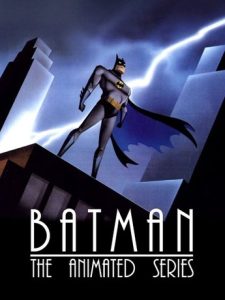 First, as promised, two additional episodes from Batman: The Animated Series. Item one is Sideshow (5/3/94). Killer Croc has been found sane and responsible for his crimes, and is being sent up the river by way of a security train, chained with an alloy believed to be so strong even Croc can’t break it. The prisoner move is accompanied by several members of the press in the next car. Croc, however, has his own ideas of the event, and points out to his guard that whoever designed these chains may have calculated them to be stronger than the might of his arms, but not necessarily capable of withstanding a crocodile’s jaws – the strongest on Earth. With a powerful chomp, Croc bites the chain in two, and begins tossing guards around like children’s action figures. The press men split between those wanting in to cover the story, and those wanting out to get out of range of the danger. One of them takes his own route, ripping open his shirt to reveal a gray set of tights with a bat insignia on the chest. Sure enough, as Croc climbs atop the railroad car, his ankles are encircled by a rope and weight shot from Batman’s array of weapons. This isn’t going to stop croc for long, so Batman adds a shot of sedative from a tranquilizer dart, hoping to knock Croc out. Croc is too strong for both shots, and, after tossing Batman around, leaps from the train. Batman dives at him, but Croc catches hold of Batman’s cape, dragging him down into a ravine in a spectacular fall. Croc revives, groggy from the sedative, but Batman is knocked cold, laying helpless on the ground. Croc lifts a large boulder, intending to crush his adversary’s head with it, but the drug continues to weaken him, causing his toss to narrowly miss Batman’s cranium, and Croc to stagger into a crawl upon his knees.
First, as promised, two additional episodes from Batman: The Animated Series. Item one is Sideshow (5/3/94). Killer Croc has been found sane and responsible for his crimes, and is being sent up the river by way of a security train, chained with an alloy believed to be so strong even Croc can’t break it. The prisoner move is accompanied by several members of the press in the next car. Croc, however, has his own ideas of the event, and points out to his guard that whoever designed these chains may have calculated them to be stronger than the might of his arms, but not necessarily capable of withstanding a crocodile’s jaws – the strongest on Earth. With a powerful chomp, Croc bites the chain in two, and begins tossing guards around like children’s action figures. The press men split between those wanting in to cover the story, and those wanting out to get out of range of the danger. One of them takes his own route, ripping open his shirt to reveal a gray set of tights with a bat insignia on the chest. Sure enough, as Croc climbs atop the railroad car, his ankles are encircled by a rope and weight shot from Batman’s array of weapons. This isn’t going to stop croc for long, so Batman adds a shot of sedative from a tranquilizer dart, hoping to knock Croc out. Croc is too strong for both shots, and, after tossing Batman around, leaps from the train. Batman dives at him, but Croc catches hold of Batman’s cape, dragging him down into a ravine in a spectacular fall. Croc revives, groggy from the sedative, but Batman is knocked cold, laying helpless on the ground. Croc lifts a large boulder, intending to crush his adversary’s head with it, but the drug continues to weaken him, causing his toss to narrowly miss Batman’s cranium, and Croc to stagger into a crawl upon his knees.
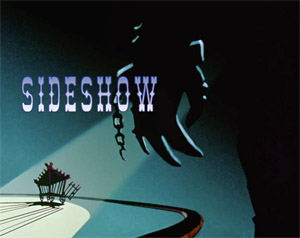 A lengthy manhunt follows through rugged terrain, as Croc gradually starts to come out from the effects of the sedative, and Barman revives to track the trail of Croc, which isn’t hard to follow. That is, until Croc reaches a wide canyon, and pushes down a substantial tree to serve as a bridge to get to the cliff rocks on the other side. Batman attempts to follow, but Croc creates an avalanche to fall upon the tree trunk, snapping it and sending Batman dropping into the canyon amidst boulders and broken limbs. Batman’s trusty grappling hook allows him to swing and climb in a swaying path to cut a route to safety through the falling debris, but the cliff face he finally reaches is a long and precarious climb, with his grappling hook apparantly out of commission for further tosses. Croc meanwhile reaches a wide river, and attempts to leap across from boulder to boulder in the river bed. A missed jump drops him into the strong current, and over a huge waterfall. The impact of the fall leaves him stunned and helpless in the water below, but a pair of youthful eyes take notice, and someone dives in to make a rescue. When Croc comes to, he finds himself in the safety of a sofa in a farmhouse. A pair of girls enter to offer him something refreshing to drink. Did I say pair? Well, it may depend on your point of view, as it is two girls, conjoined in the middle as one. Others enter the room: an eight-foot tall giant, a young boy with arms and legs that look like aquatic flippers, and a small hunchback, dressed in the garb of a ringmaster. All a group of ex-circus freaks. They explain that the boy spotted Croc’s fall from the waterfall, and fished Croc out from the river, after which the giant (Goliath) carried him to their home. The group have pooled their life-savings to pirchase the remote farm on which Croc now finds himself, as a haven for themselves away from the eyes of the world, and also for anyone else of their kind who is willing to work. Croc reacts in his typical rough around the edges way, but knows a good hideout when he sees one, so volunteers to help with the farm labor in exchange for room and board. Croc and the others exchange stories at the dinner table about themselves, Croc claiming that he too was a circus freak, abused and kept in chains (as evidenced by the manacle still around one wrist). The other freaks let slip that they still are in possession of a nest-egg of $50,000 after the farm’s purchase, leading Croc to find the present set-up even more attractive.
A lengthy manhunt follows through rugged terrain, as Croc gradually starts to come out from the effects of the sedative, and Barman revives to track the trail of Croc, which isn’t hard to follow. That is, until Croc reaches a wide canyon, and pushes down a substantial tree to serve as a bridge to get to the cliff rocks on the other side. Batman attempts to follow, but Croc creates an avalanche to fall upon the tree trunk, snapping it and sending Batman dropping into the canyon amidst boulders and broken limbs. Batman’s trusty grappling hook allows him to swing and climb in a swaying path to cut a route to safety through the falling debris, but the cliff face he finally reaches is a long and precarious climb, with his grappling hook apparantly out of commission for further tosses. Croc meanwhile reaches a wide river, and attempts to leap across from boulder to boulder in the river bed. A missed jump drops him into the strong current, and over a huge waterfall. The impact of the fall leaves him stunned and helpless in the water below, but a pair of youthful eyes take notice, and someone dives in to make a rescue. When Croc comes to, he finds himself in the safety of a sofa in a farmhouse. A pair of girls enter to offer him something refreshing to drink. Did I say pair? Well, it may depend on your point of view, as it is two girls, conjoined in the middle as one. Others enter the room: an eight-foot tall giant, a young boy with arms and legs that look like aquatic flippers, and a small hunchback, dressed in the garb of a ringmaster. All a group of ex-circus freaks. They explain that the boy spotted Croc’s fall from the waterfall, and fished Croc out from the river, after which the giant (Goliath) carried him to their home. The group have pooled their life-savings to pirchase the remote farm on which Croc now finds himself, as a haven for themselves away from the eyes of the world, and also for anyone else of their kind who is willing to work. Croc reacts in his typical rough around the edges way, but knows a good hideout when he sees one, so volunteers to help with the farm labor in exchange for room and board. Croc and the others exchange stories at the dinner table about themselves, Croc claiming that he too was a circus freak, abused and kept in chains (as evidenced by the manacle still around one wrist). The other freaks let slip that they still are in possession of a nest-egg of $50,000 after the farm’s purchase, leading Croc to find the present set-up even more attractive.
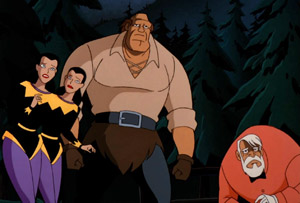 At night, Croc scouts around the home, locating a secret compartment in which the savings are stashed. He is interrupted when the boy appears, asking him what he’s doing, and Croc covers by claiming he was looking for extra blankets. But a sound outside causes further interruption – the approach of the Bat. Croc and Batman engage in some fighting, but the odds turn against Batman when Croc, as the others approach to witness the scuffle, tells the freaks that Batman is the one who previously enslaved him. Goliath enters the battle on Croc’s side, and the two powerful allies are too much for Batman, who is locked in an old circus wagon without his utility belt. Batman attempts to get the freaks to listen to reason, insisting that Croc is an escaped killer. The freaks, however, believe Croc’s manacles lend more credence to Croc’s side of the story. All might have ended happily for Croc, but the brutal criminal is not content with leaving Batman in a cage. Croc claims that if Batman escapes, he will bring others who will never let he and his fellow freaks have a moment’s peace – so announces that the Bat must go. Croc grabs a pitchfork, and attempts to spear Batman in the cage like a fish trapped in a barrel. Goliath grabs the pitchfork from Croc and snaps it in two, insisting, “No killing.” Croc’s unexplainable actions lead the other freaks to believe that perhaps Batman was indeed telling the truth. Before the freaks can pass verdict on Croc, Croc decides to take the safe way out, grabbing up a gas pellet from Batman’s utility belt, and bursting it to release gas and knock the freaks out. Croc takes the hidden stash of cash, then turns in attempt to finish off Batman with a rifle from the farmhouse. But Batman has managed to remove a chock from under the wheel of the circus wagon, and a shift of weight sends the wagon rolling after Croc. Croc flings himself to the ground, allowing the wagon to roll over him, and the wagon hits an obstacle and flips over, freeing Batman. The revived Goliath joins Batman, forcing Croc to take refuge in the farmhouse, still armed. With the seal-boy’s help, Barman swings in through an upper-story entrance, forcing the battle outside. Batman and Croc fight fiercely atop a mill wheel, where Croc is ultimately knocked out amidst the mill’s gears, and recaptured. In a new array of firmer straight jackets, alloy chains, and muzzle helmet to prevent further biting, Croc is made ready for haul-away by helicopter. The boy asks why Croc turned on them, stating that they might have been able to help him. Croc reminds the boy of an earlier remark he had made about the farm being the perfect place to just be yourself. “I guess I was just being myself”, admits Croc, as the helicopter lifts him into the sky, and on to his final incarceration.
At night, Croc scouts around the home, locating a secret compartment in which the savings are stashed. He is interrupted when the boy appears, asking him what he’s doing, and Croc covers by claiming he was looking for extra blankets. But a sound outside causes further interruption – the approach of the Bat. Croc and Batman engage in some fighting, but the odds turn against Batman when Croc, as the others approach to witness the scuffle, tells the freaks that Batman is the one who previously enslaved him. Goliath enters the battle on Croc’s side, and the two powerful allies are too much for Batman, who is locked in an old circus wagon without his utility belt. Batman attempts to get the freaks to listen to reason, insisting that Croc is an escaped killer. The freaks, however, believe Croc’s manacles lend more credence to Croc’s side of the story. All might have ended happily for Croc, but the brutal criminal is not content with leaving Batman in a cage. Croc claims that if Batman escapes, he will bring others who will never let he and his fellow freaks have a moment’s peace – so announces that the Bat must go. Croc grabs a pitchfork, and attempts to spear Batman in the cage like a fish trapped in a barrel. Goliath grabs the pitchfork from Croc and snaps it in two, insisting, “No killing.” Croc’s unexplainable actions lead the other freaks to believe that perhaps Batman was indeed telling the truth. Before the freaks can pass verdict on Croc, Croc decides to take the safe way out, grabbing up a gas pellet from Batman’s utility belt, and bursting it to release gas and knock the freaks out. Croc takes the hidden stash of cash, then turns in attempt to finish off Batman with a rifle from the farmhouse. But Batman has managed to remove a chock from under the wheel of the circus wagon, and a shift of weight sends the wagon rolling after Croc. Croc flings himself to the ground, allowing the wagon to roll over him, and the wagon hits an obstacle and flips over, freeing Batman. The revived Goliath joins Batman, forcing Croc to take refuge in the farmhouse, still armed. With the seal-boy’s help, Barman swings in through an upper-story entrance, forcing the battle outside. Batman and Croc fight fiercely atop a mill wheel, where Croc is ultimately knocked out amidst the mill’s gears, and recaptured. In a new array of firmer straight jackets, alloy chains, and muzzle helmet to prevent further biting, Croc is made ready for haul-away by helicopter. The boy asks why Croc turned on them, stating that they might have been able to help him. Croc reminds the boy of an earlier remark he had made about the farm being the perfect place to just be yourself. “I guess I was just being myself”, admits Croc, as the helicopter lifts him into the sky, and on to his final incarceration.
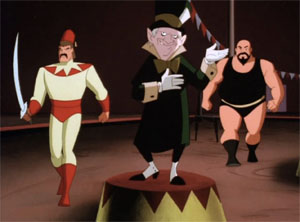 Animal Act (9/26/98) takes place at a later point in the series, where Dick Grayson has moved from his former identity as Robin, to a new solo crime-fighting career as Nightwing. However, this doesn’t stop renewing old acquaintances, and Dick, Batman, and a new junior Robin-in-training man an evening patrol together. A theft is observed of some microchip circuitry from a tall transmission tower. The trench-coated thug puts up a surprisingly powerful fight, and shows amazing agility in attempting a getaway. The thief’s face remains concealed under the brim of a large hat, until Nightwing manages to knock the hat away, revealing – a gorilla! More upsetting to Dick is that he is sure he recognizes the gorilla from his days with the circus – but the gorilla shows him no recognition. The ape escapes, and as Dick’s old circus is playing town, Dick and the new Robin pay a visit to the show in street clothes to investigate. Dick is well-remembered by most of the performers, including by a young girl of Dick’s age who has grown to take over the family trade of animal training. The gorilla is now her charge, and surprisingly, the gorilla seems to instantly recognize Dick from its cage, and acts as gently as a lamb. What is going on? Batman reports from a check of his computer that there is definitely a correlation between cities the circus has played and a wave of thefts of hi-tech electronic and computer hardware. Dick vouches for the veracity of the girl he knew as a youth, but Batman leaves her on the suspect list, wondering if Dick only knows the girl she was, not the one she is now.
Animal Act (9/26/98) takes place at a later point in the series, where Dick Grayson has moved from his former identity as Robin, to a new solo crime-fighting career as Nightwing. However, this doesn’t stop renewing old acquaintances, and Dick, Batman, and a new junior Robin-in-training man an evening patrol together. A theft is observed of some microchip circuitry from a tall transmission tower. The trench-coated thug puts up a surprisingly powerful fight, and shows amazing agility in attempting a getaway. The thief’s face remains concealed under the brim of a large hat, until Nightwing manages to knock the hat away, revealing – a gorilla! More upsetting to Dick is that he is sure he recognizes the gorilla from his days with the circus – but the gorilla shows him no recognition. The ape escapes, and as Dick’s old circus is playing town, Dick and the new Robin pay a visit to the show in street clothes to investigate. Dick is well-remembered by most of the performers, including by a young girl of Dick’s age who has grown to take over the family trade of animal training. The gorilla is now her charge, and surprisingly, the gorilla seems to instantly recognize Dick from its cage, and acts as gently as a lamb. What is going on? Batman reports from a check of his computer that there is definitely a correlation between cities the circus has played and a wave of thefts of hi-tech electronic and computer hardware. Dick vouches for the veracity of the girl he knew as a youth, but Batman leaves her on the suspect list, wondering if Dick only knows the girl she was, not the one she is now.
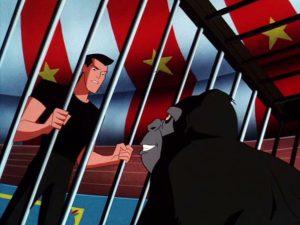 A call comes over police radio of another theft in progress from a technology storehouse. Batman and Nightwing respond to the call, finding the warehouse being raided by two huge brown bears. A battle using a forklift and a high-pressure fire hose as weapons rounds up the bear culprits, who are again traced back to the circus as escaped from the grounds – and as trained by the same girl trainer as the gorilla. She claims she did not leave the cage lock opened, and the bears seem to respond normally in being corralled back into their cage. She tells Dick that she believes someone is messing with her animals. It would definitely seem that some human intervention is involved, as Batman arrives with security video from the scene of the break-in – showing the bears clearly punching in an extended security code at the warehouse door with their claws! How do you train a bear to perform such a feat?
A call comes over police radio of another theft in progress from a technology storehouse. Batman and Nightwing respond to the call, finding the warehouse being raided by two huge brown bears. A battle using a forklift and a high-pressure fire hose as weapons rounds up the bear culprits, who are again traced back to the circus as escaped from the grounds – and as trained by the same girl trainer as the gorilla. She claims she did not leave the cage lock opened, and the bears seem to respond normally in being corralled back into their cage. She tells Dick that she believes someone is messing with her animals. It would definitely seem that some human intervention is involved, as Batman arrives with security video from the scene of the break-in – showing the bears clearly punching in an extended security code at the warehouse door with their claws! How do you train a bear to perform such a feat?
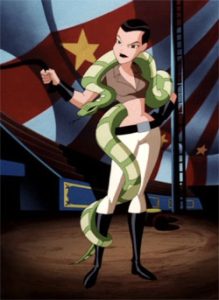 A silent clown has been hanging around the circus grounds, pulling little irritating jokes on everyone. No one seems to know who he is, until the girl trainer catches him lingering outside the cage bars of one her animals. The mime breaks his silence, tips his hat, and in Lewis Carrill-style prose introduces himself – The Mad Hatter. Before the girl can do anything about it, the Hatter slips her a hair-clip – equipped with electronics. In the finale of the episode, Batman and Nightwing find themselves inside the big top, surrounded by the girl and all the other circus performers, all seeming not to hear them or recognize them, but advancing upon them at the mental command of the Hatter, acting as Ringmaster. The Hatter discloses he has slipped all the performers mind-control devices, as he had previously with the animals, and our heroes attempt to avoid the combined perils of attacks by the strong man, an axe-thrower, sword-swallower, and a fire-eater, among others. The fire eater breathes streams of flame like a blow torch, attempting to hit Batman. The caped crusader ducks, and the flame ignites the top of the Hatter’s hat, dissolving the circuitry by which the Hatter is exerting his mind control. The circus performers come to, and Hatter is left without a supporting army. Thinking the remnants of his hat might still have some control over the weaker brains of dumb animals, Hatter runs to the gorilla cage and unlocks the door. But a snap of a ringmaster’s whip snatches the remaining hat from his brow, and another whup crack slices it in two. Hatter is forced to resort to old-fashioned firearms to fend off Batman and Nightwing, but forgets about the open cage door. The gorilla emerges, and pounces upon the back of Hatter, pinning him to the ground and repeatedly bouncing on him, while beating its chest in victory. Someone asks the girl trainer if she is planning to call the beast off. She replies, “Eventually.” The film ends with everything back to normal, with the addition of the young Robin having volunteered to join the show for its short stay. His assignment – sweep out fly-infested animal cages. Nightwing remarks that this really reminds him how much he misses show business.
A silent clown has been hanging around the circus grounds, pulling little irritating jokes on everyone. No one seems to know who he is, until the girl trainer catches him lingering outside the cage bars of one her animals. The mime breaks his silence, tips his hat, and in Lewis Carrill-style prose introduces himself – The Mad Hatter. Before the girl can do anything about it, the Hatter slips her a hair-clip – equipped with electronics. In the finale of the episode, Batman and Nightwing find themselves inside the big top, surrounded by the girl and all the other circus performers, all seeming not to hear them or recognize them, but advancing upon them at the mental command of the Hatter, acting as Ringmaster. The Hatter discloses he has slipped all the performers mind-control devices, as he had previously with the animals, and our heroes attempt to avoid the combined perils of attacks by the strong man, an axe-thrower, sword-swallower, and a fire-eater, among others. The fire eater breathes streams of flame like a blow torch, attempting to hit Batman. The caped crusader ducks, and the flame ignites the top of the Hatter’s hat, dissolving the circuitry by which the Hatter is exerting his mind control. The circus performers come to, and Hatter is left without a supporting army. Thinking the remnants of his hat might still have some control over the weaker brains of dumb animals, Hatter runs to the gorilla cage and unlocks the door. But a snap of a ringmaster’s whip snatches the remaining hat from his brow, and another whup crack slices it in two. Hatter is forced to resort to old-fashioned firearms to fend off Batman and Nightwing, but forgets about the open cage door. The gorilla emerges, and pounces upon the back of Hatter, pinning him to the ground and repeatedly bouncing on him, while beating its chest in victory. Someone asks the girl trainer if she is planning to call the beast off. She replies, “Eventually.” The film ends with everything back to normal, with the addition of the young Robin having volunteered to join the show for its short stay. His assignment – sweep out fly-infested animal cages. Nightwing remarks that this really reminds him how much he misses show business.
Watch this one HERE.
 Speaking of the DC Universe, Ruby-Spears produced a short-lived incarnation of Superman in 1988, which, while perhaps a notch above the Hanna-Barbera “Super Friends”, fell far short of the later Warner Brothers’ standard. A recurring feature of the show was glimpses back into Superman’s Family Album, at moments from his childhood upbringing with the Kents. This resulted in The Circus (10/22/88). The Kent family attends the big show, and Clark is asked to pick up drinks for all before the show begins. He dallies from his mission to pick up a pinwheel “whirlie” on a stick, and observe a sideshow attraction of a half-woman, half-spider. The curtain opens upon a woman’s head seemingly attached to a spider’s body. Thinking her a dangerous monster, Clark reflexively blows at her with his super breath, blowing apart the fake costume the woman is wearing around her neck. Oops. Clark makes a hasty exit, but while standing near a tent opening, is seized around the leg by an elephant’s trunk. The elephant, apparently having mistaken Clark for a junior rider, playfully places Clark atop his back. Clark drops the whirlie, and has to fly down to get it. The elephant shifts its weight, blocking access to the toy, and Clark lifts the elephant off the ground to retrieve it. Realizing the Kents must be worrying about him by now, Clark runs outside, but trips over a mooring rope supporting the tent. The drinks fly out of hs hand, and Clark uses super speed to catch all three without spilling a drop. But the whirlie has fallen to the ground, and as Clark bends to get it while balancing the drinks, he splits the seat of his pants. He backs into another tent, which turns out to be the wardrobe tent. There, he spots a junior acrobat’s outfit just his size, which he substitutes for his own clothes, and a small face mask which he tries on. “Not bad”, he remarks.
Speaking of the DC Universe, Ruby-Spears produced a short-lived incarnation of Superman in 1988, which, while perhaps a notch above the Hanna-Barbera “Super Friends”, fell far short of the later Warner Brothers’ standard. A recurring feature of the show was glimpses back into Superman’s Family Album, at moments from his childhood upbringing with the Kents. This resulted in The Circus (10/22/88). The Kent family attends the big show, and Clark is asked to pick up drinks for all before the show begins. He dallies from his mission to pick up a pinwheel “whirlie” on a stick, and observe a sideshow attraction of a half-woman, half-spider. The curtain opens upon a woman’s head seemingly attached to a spider’s body. Thinking her a dangerous monster, Clark reflexively blows at her with his super breath, blowing apart the fake costume the woman is wearing around her neck. Oops. Clark makes a hasty exit, but while standing near a tent opening, is seized around the leg by an elephant’s trunk. The elephant, apparently having mistaken Clark for a junior rider, playfully places Clark atop his back. Clark drops the whirlie, and has to fly down to get it. The elephant shifts its weight, blocking access to the toy, and Clark lifts the elephant off the ground to retrieve it. Realizing the Kents must be worrying about him by now, Clark runs outside, but trips over a mooring rope supporting the tent. The drinks fly out of hs hand, and Clark uses super speed to catch all three without spilling a drop. But the whirlie has fallen to the ground, and as Clark bends to get it while balancing the drinks, he splits the seat of his pants. He backs into another tent, which turns out to be the wardrobe tent. There, he spots a junior acrobat’s outfit just his size, which he substitutes for his own clothes, and a small face mask which he tries on. “Not bad”, he remarks.
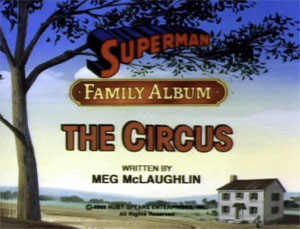 A hand reaches into the tent, tugging him by the shoulder into the adjoining big top, as a voice addresses him, “Come on, Gino, that’s our cue.” Before Clark knows it, he has been taken up a ladder to a tightrope platform with three other older performers. The three, with one balanced on another’s shoulders, step out onto the rope, and call for Gino. “What’s so hard about this?”, says Clark, stepping out with them. The rope begins to sway up and down with each of the acrobats’ steps, making Clark fear spilling his drinks – so he chooses to hover inches above the wire. He decides to improvise, easily juggling his drink cups, then landing back on the wire. His landing and the startling sight of the performance cause the two stacked acrobats to topple and fall. “Omigosh”, reacts Clark, and leaps off the wire, tossing the drinks into the air, and soaring down to grab the two acrobats by the shoulders of their tights, then slowing to float them gently down to the arena floor. To top it, he catches the falling drinks again without spilling. The audience reacts with an ovation. “The greatest act I ever saw!” “It’s super-human.” The suspicious Kents exchange looks, and remark simultaneously, “Clark.” Pretty sure he’s in for it, Clark disappears from sight, and somehow manages to regain his old clothes (without explanation as to whether or not he repaired the pants rip). Clark finally joins his adopted parents in the grandstand, delivering the drinks. The Kents choose not to let on that they know of his acrobatic feat, and ask him where he’s been for so long. Clark responds, “Uh, it was a really long line.” Clark takes his seat, and all is silently forgiven, as the family album closes on an old snapshot of the Kents at the show, for the fade out.
A hand reaches into the tent, tugging him by the shoulder into the adjoining big top, as a voice addresses him, “Come on, Gino, that’s our cue.” Before Clark knows it, he has been taken up a ladder to a tightrope platform with three other older performers. The three, with one balanced on another’s shoulders, step out onto the rope, and call for Gino. “What’s so hard about this?”, says Clark, stepping out with them. The rope begins to sway up and down with each of the acrobats’ steps, making Clark fear spilling his drinks – so he chooses to hover inches above the wire. He decides to improvise, easily juggling his drink cups, then landing back on the wire. His landing and the startling sight of the performance cause the two stacked acrobats to topple and fall. “Omigosh”, reacts Clark, and leaps off the wire, tossing the drinks into the air, and soaring down to grab the two acrobats by the shoulders of their tights, then slowing to float them gently down to the arena floor. To top it, he catches the falling drinks again without spilling. The audience reacts with an ovation. “The greatest act I ever saw!” “It’s super-human.” The suspicious Kents exchange looks, and remark simultaneously, “Clark.” Pretty sure he’s in for it, Clark disappears from sight, and somehow manages to regain his old clothes (without explanation as to whether or not he repaired the pants rip). Clark finally joins his adopted parents in the grandstand, delivering the drinks. The Kents choose not to let on that they know of his acrobatic feat, and ask him where he’s been for so long. Clark responds, “Uh, it was a really long line.” Clark takes his seat, and all is silently forgiven, as the family album closes on an old snapshot of the Kents at the show, for the fade out.
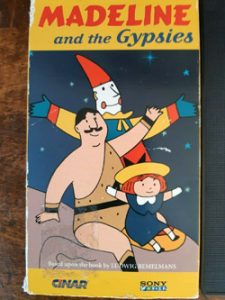 Turning in a completely different direction, Ludwig Bemelmans’ Madeline and the Gypsies, was filmed twice, first as a short by Gene Deitch’s Rembrandt Films which did not have sufficient running time to do it justice, and, more effectively, in a 10/14/91 half-hour special produced for the Family Channel by CINAR, France Animation S.A., and Crayon Animation. A simple tale, of Madeline and a little boy named Pepito attending a gypsy circus/carnival along with Miss Clavelle and the other 11 children under her charge. A Ferris wheel ride turns into a peril when a lightning storm breaks out. The 11 other girls are rescued from the ride and taken home by taxi with Miss Clavelle, but somehow, Madeline and Pepito are overlooked, and remain stranded in an upper Ferris wheel chair. The winds blow a stray length of rope up to the chair, and Madeline ties it to the railing while Pepito climbs down. He arouses the gypsies to the trouble, and the strong man, a clown, and an elephant stack one atop another to reach Madeline and carry her to safety. The children are fed a meal, and when the storm clears told to return home by taxi. Instead, they stow away in a gypsy wagon and run off with the show. The head gypsy permits them to stay for a time, with their promise to earn their keep, and write home. They post a letter to Miss Clavelle, but it communicates little except the postmark, as their spelling is terrible. Nevertheless, the postmark provides a clue, and Miss Clavelle, the eleven other girls, and Pepito’s parents embark by train to the location in attempt to find the two runaways.
Turning in a completely different direction, Ludwig Bemelmans’ Madeline and the Gypsies, was filmed twice, first as a short by Gene Deitch’s Rembrandt Films which did not have sufficient running time to do it justice, and, more effectively, in a 10/14/91 half-hour special produced for the Family Channel by CINAR, France Animation S.A., and Crayon Animation. A simple tale, of Madeline and a little boy named Pepito attending a gypsy circus/carnival along with Miss Clavelle and the other 11 children under her charge. A Ferris wheel ride turns into a peril when a lightning storm breaks out. The 11 other girls are rescued from the ride and taken home by taxi with Miss Clavelle, but somehow, Madeline and Pepito are overlooked, and remain stranded in an upper Ferris wheel chair. The winds blow a stray length of rope up to the chair, and Madeline ties it to the railing while Pepito climbs down. He arouses the gypsies to the trouble, and the strong man, a clown, and an elephant stack one atop another to reach Madeline and carry her to safety. The children are fed a meal, and when the storm clears told to return home by taxi. Instead, they stow away in a gypsy wagon and run off with the show. The head gypsy permits them to stay for a time, with their promise to earn their keep, and write home. They post a letter to Miss Clavelle, but it communicates little except the postmark, as their spelling is terrible. Nevertheless, the postmark provides a clue, and Miss Clavelle, the eleven other girls, and Pepito’s parents embark by train to the location in attempt to find the two runaways.
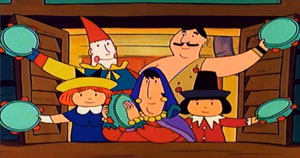 Madeline and Pepito attempt to train as bareback riders, bur get easily exhausted from the hard work. A problem faces the show, as the lion for the lion-taming act comes down sick, and no substitute can be found. The head gypsy has an idea, and retrieves an old lion costume from a trunk. Madeline and Pepito are sewn in, and rehearse jumping through a hoop, and having the trainer put his head in the lion’s mouth. But before the show that evening, Madeline and Pepito realize it’s not so hot (or perhaps, too hot) being sewn into a lion skin, and quite inconvenient for taking a casual walk down a country lane, as their presence frightens farm animals and causes a farmer to attempt to shoot them with a shotgun. They begin to miss their old lives, and wish they could return home. That night, the evening performance goes reasonably well, but Madeline spots something more appealing than the applauding audience. Miss Clavelle and Pepito’s parents have arrived, and, not knowing where to search, have chosen to kill a little time with the girls by attending the show in the front row. For once, Madeline and Pepito easily clear a high jump through the trainer’s hoop, and race to the railing in front of Miss Clavelle, frightening the other girls and most of the audience. But Madeline’s voice from inside the costume gives things away, and all she asks is for her and Pepito to come back home and give Miss Clavelle a big hug. After a tearful goodbye to the gypsies, all ends well – “and that’s all there is…There isn’t any more.”
Madeline and Pepito attempt to train as bareback riders, bur get easily exhausted from the hard work. A problem faces the show, as the lion for the lion-taming act comes down sick, and no substitute can be found. The head gypsy has an idea, and retrieves an old lion costume from a trunk. Madeline and Pepito are sewn in, and rehearse jumping through a hoop, and having the trainer put his head in the lion’s mouth. But before the show that evening, Madeline and Pepito realize it’s not so hot (or perhaps, too hot) being sewn into a lion skin, and quite inconvenient for taking a casual walk down a country lane, as their presence frightens farm animals and causes a farmer to attempt to shoot them with a shotgun. They begin to miss their old lives, and wish they could return home. That night, the evening performance goes reasonably well, but Madeline spots something more appealing than the applauding audience. Miss Clavelle and Pepito’s parents have arrived, and, not knowing where to search, have chosen to kill a little time with the girls by attending the show in the front row. For once, Madeline and Pepito easily clear a high jump through the trainer’s hoop, and race to the railing in front of Miss Clavelle, frightening the other girls and most of the audience. But Madeline’s voice from inside the costume gives things away, and all she asks is for her and Pepito to come back home and give Miss Clavelle a big hug. After a tearful goodbye to the gypsies, all ends well – “and that’s all there is…There isn’t any more.”
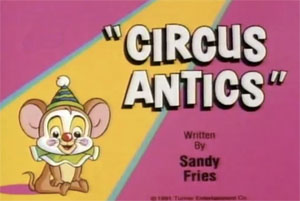 Even in the 1990’s, Hanna-Barbera continued to churn out mostly lame circus tales. The Tom and Jerry Kids Show was another higher-budgeted-than-before attempt to milk some life out of the cat and mouse, often falling short and prone to repetition of old themes. Circus Antics (9/14/91) repeats the old setup of the theatrical, “The Bodyguard”, with a touch of Tex Avery’s Bad Luck Blackie tossed in. Tom pursues Jerry on the circus grounds, including in a carnival booth that confusingly combines the target of a moving conveyor-belt of flat metal ducks with the non-violent weapon of baseball-throwing instead of rifle bullets. (Would this even work mechanically?) Tom trips up an elephant, who lands upon him. Tom gets revenge by tying the elephant’s trunk in a knot. Jerry undoes the knot and becomes the elephant’s friend, receiving a whistle to summon the elephant whenever he needs assistance. Running gag has the elephant repeatedly landing upon Tom when the whistle is blown, including once from the unexpected location of balancing over Tom on the high wire. As in Avery’s classic, Tom swallows the whistle, and the elephant appears everywhere Tom hiccups. The whistle is finally knocked loose from Tom’s throat and returned to Jerry. But a note on a circus tent gives Tom one last opportunity, informing the reader that the elephant has gone off briefly to visit his family. Tom corners Jerry, and Jerry blows, but with no immediate result. Tom is about to let Jerry have it, when a large shadow covers him from the sky. “We’re back”, shouts the elephant’s voice, as he and his entire family land atop Tom in a pig pile. You get the idea.
Even in the 1990’s, Hanna-Barbera continued to churn out mostly lame circus tales. The Tom and Jerry Kids Show was another higher-budgeted-than-before attempt to milk some life out of the cat and mouse, often falling short and prone to repetition of old themes. Circus Antics (9/14/91) repeats the old setup of the theatrical, “The Bodyguard”, with a touch of Tex Avery’s Bad Luck Blackie tossed in. Tom pursues Jerry on the circus grounds, including in a carnival booth that confusingly combines the target of a moving conveyor-belt of flat metal ducks with the non-violent weapon of baseball-throwing instead of rifle bullets. (Would this even work mechanically?) Tom trips up an elephant, who lands upon him. Tom gets revenge by tying the elephant’s trunk in a knot. Jerry undoes the knot and becomes the elephant’s friend, receiving a whistle to summon the elephant whenever he needs assistance. Running gag has the elephant repeatedly landing upon Tom when the whistle is blown, including once from the unexpected location of balancing over Tom on the high wire. As in Avery’s classic, Tom swallows the whistle, and the elephant appears everywhere Tom hiccups. The whistle is finally knocked loose from Tom’s throat and returned to Jerry. But a note on a circus tent gives Tom one last opportunity, informing the reader that the elephant has gone off briefly to visit his family. Tom corners Jerry, and Jerry blows, but with no immediate result. Tom is about to let Jerry have it, when a large shadow covers him from the sky. “We’re back”, shouts the elephant’s voice, as he and his entire family land atop Tom in a pig pile. You get the idea.
 Repetition upon repetition? Circus Cat (9/12/92) is practically the same tale, substituting Simba the circus lion as Jerry’s new friend (a lion whose ancestor was the jungle king who had a thorn removed from his paw by a mouse). This time, Jerry has to honk the seal’s horns to get the lion to sock Tom. This allows for one surprise gag where Tom pursues Jerry in a clown’s car, choosing to repeatedly honk the horn. The lion’s fist appears in Tom’s face, but then the lion apologizes. “Sorry, pal. Wrong horn.” The film even goes so far as to include a throwaway gag of an elephant landing on Tom, seemingly lifted right out of the last cartoon!
Repetition upon repetition? Circus Cat (9/12/92) is practically the same tale, substituting Simba the circus lion as Jerry’s new friend (a lion whose ancestor was the jungle king who had a thorn removed from his paw by a mouse). This time, Jerry has to honk the seal’s horns to get the lion to sock Tom. This allows for one surprise gag where Tom pursues Jerry in a clown’s car, choosing to repeatedly honk the horn. The lion’s fist appears in Tom’s face, but then the lion apologizes. “Sorry, pal. Wrong horn.” The film even goes so far as to include a throwaway gag of an elephant landing on Tom, seemingly lifted right out of the last cartoon!
 Back-tracking in chronology to an item not previously mentioned, The Kwicky Koala Show may have been the ultimate in repetition, with one joke seeming to provide the fodder for the entire series. A Droopy-esque koala bear is endlessly pursued by a wolf as prospective dinner, but always evades the wolf’s call of “Gotcha” in effortless manner by means of turning on super-speed at will that blinks him instantly from one position to another, seemingly without moving a muscle. All that really changed between one episode and another (maybe between one gag and another) was the background setting. Kwicky’s Karnival Kapers (11/28/81) is the same old story, with the Wolf mixing up a tempting treat for Kwicky of cotton candy mixed with eucalyptus leaves, but making an enemy of a circus strong man who unintentionally gets the treat instead. The wolf s ultimately shot out of a cannon, and ends the cartoon stranded on an asteroid, thumbing for a lift from any passing flying saucer to get home. The series also included interstitial sequences by the Bungle Brothers – a re-design for Tex Avery’s George and Junior – performing various stage acts, several of which deal with staples of circus performances. Results were typically predictable.
Back-tracking in chronology to an item not previously mentioned, The Kwicky Koala Show may have been the ultimate in repetition, with one joke seeming to provide the fodder for the entire series. A Droopy-esque koala bear is endlessly pursued by a wolf as prospective dinner, but always evades the wolf’s call of “Gotcha” in effortless manner by means of turning on super-speed at will that blinks him instantly from one position to another, seemingly without moving a muscle. All that really changed between one episode and another (maybe between one gag and another) was the background setting. Kwicky’s Karnival Kapers (11/28/81) is the same old story, with the Wolf mixing up a tempting treat for Kwicky of cotton candy mixed with eucalyptus leaves, but making an enemy of a circus strong man who unintentionally gets the treat instead. The wolf s ultimately shot out of a cannon, and ends the cartoon stranded on an asteroid, thumbing for a lift from any passing flying saucer to get home. The series also included interstitial sequences by the Bungle Brothers – a re-design for Tex Avery’s George and Junior – performing various stage acts, several of which deal with staples of circus performances. Results were typically predictable.
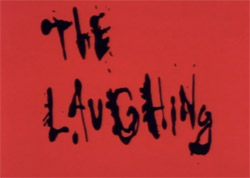 By the time of Dexter’s Laboratory, situations had improved, because Hanna and Barbera were functionally out of the picture, and independent producers were actually behind the wheel with the assistance of Cartoon Network. A creative episode good for a few laughs is The Laughing (1/21/98). It us Dee Dee’s birthday, and a surprise party has been planned by the parents – something that appears to be altogether new to the younger Dexter, who is wise in science but entirely naive about the experiences other kids find familiar. Mom has hired a birthday clown for the entertainment – something that Dexter has never seen. He tries to analyze scientifically what kind of odd species this creature is. The clown twists balloons into animals, as Dexter deduces he is a “shape-shifter”. The clown bakes a pie in seconds in an oven, tosses the dessert over his shoulder, and hits himself in the face with it on the opposite side of the yard. “He’s crazy!”, mutters a worried Dexter. The clown tells an old joke (“Why is 6 afraid of 7? Because 7-8-9.”), and Dexter doesn’t get it. As the clown laughs himself silly at his own riddle, he trips over a rock in the yard, sending his false teeth flying out of his mouth. The dentures place the bite upon Dexter’s arm. “Oops. Sorry, kid”, apologizes the clown, retrieving his bridgework. That night at the dinner table, as the moon rises outside, all but Dexter laugh at Dee Dee’s repeating of the clown’s number riddle. Dexter sits grumpy and unmoved – but to his own surprise, suddenly begins to giggle, then to guffaw, then to chortle, uncontrollably – and has no idea why, as he still doesn’t get the joke. He excuses himself to his room, and still can’t control his laughing fit, rolling on his stomach and pounding the floor. With a snap here and a pop there, he undergoes a physical transformation, developing buck teeth, oversize shoed-feet, white gloves, a red nose, and a pasty-white complexion. As Dee Dee looks in on him, Dexter is disappearing out the window – transformed completely to a circus clown. Dexter spends the night pranking people in the park, with lathe same lame joke, boxes full of springing mock-snakes, and shooting at them with toy guns with emerging flag that says “Bang”.
By the time of Dexter’s Laboratory, situations had improved, because Hanna and Barbera were functionally out of the picture, and independent producers were actually behind the wheel with the assistance of Cartoon Network. A creative episode good for a few laughs is The Laughing (1/21/98). It us Dee Dee’s birthday, and a surprise party has been planned by the parents – something that appears to be altogether new to the younger Dexter, who is wise in science but entirely naive about the experiences other kids find familiar. Mom has hired a birthday clown for the entertainment – something that Dexter has never seen. He tries to analyze scientifically what kind of odd species this creature is. The clown twists balloons into animals, as Dexter deduces he is a “shape-shifter”. The clown bakes a pie in seconds in an oven, tosses the dessert over his shoulder, and hits himself in the face with it on the opposite side of the yard. “He’s crazy!”, mutters a worried Dexter. The clown tells an old joke (“Why is 6 afraid of 7? Because 7-8-9.”), and Dexter doesn’t get it. As the clown laughs himself silly at his own riddle, he trips over a rock in the yard, sending his false teeth flying out of his mouth. The dentures place the bite upon Dexter’s arm. “Oops. Sorry, kid”, apologizes the clown, retrieving his bridgework. That night at the dinner table, as the moon rises outside, all but Dexter laugh at Dee Dee’s repeating of the clown’s number riddle. Dexter sits grumpy and unmoved – but to his own surprise, suddenly begins to giggle, then to guffaw, then to chortle, uncontrollably – and has no idea why, as he still doesn’t get the joke. He excuses himself to his room, and still can’t control his laughing fit, rolling on his stomach and pounding the floor. With a snap here and a pop there, he undergoes a physical transformation, developing buck teeth, oversize shoed-feet, white gloves, a red nose, and a pasty-white complexion. As Dee Dee looks in on him, Dexter is disappearing out the window – transformed completely to a circus clown. Dexter spends the night pranking people in the park, with lathe same lame joke, boxes full of springing mock-snakes, and shooting at them with toy guns with emerging flag that says “Bang”.
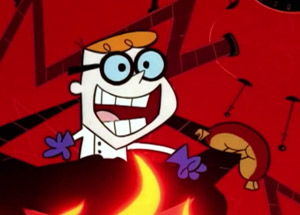 The next morning, Dexter awakens in his room, his old-self – but the floor is covered in balloons. And Dee Dee is also there, staring at him with a smile that reads, I know something you don’t know. She is delighted to find that Dexter doesn’t remember a thing about last night, and shows him a newspaper headline story reading “Crazy Clown Loose in Town”. “What does that have to do with me?” asks Dexter, as Dee Dee tells him to take a closer look at a photo of the clown in the article. Grabbing a crayon, she sketches an outline in the shape of Dexter underneath the clown makeup, and Dexter gets the idea who is inside. Dexter doesn’t even wait for Dee Dee to complete her next sentence to him, but vanishes into his laboratory, undergoing a complete physical check-over by his computer analysis equipment. The computer discerns the point of entry into Dexter’s system as a bite on the funny bone in his arm from the clown dentures – infecting him with an unidentifiable substance. Dexter orders the computer to find an antidote. The computer analyzes, calculates, and Dexter waits, and waits, and waits, until it is well past his bedtime at night. The moon rises again, and the laughter begins to swell in Dexter once more. As his hair transforms into a fright wig, and his shoes grow ro oversize proportions once again, Dexter staggers into Dee Dee’s room, begging for help – until he is completely transformed into the clown again. He throws the same old joke at Dee Dee, who of course this time already knows the answer, so Dexter awards her a prize of an exploding cigar. As Dee Dee has her face blackened by the explosion, she realizes she’d better help her brother out, before he hurts somebody.
The next morning, Dexter awakens in his room, his old-self – but the floor is covered in balloons. And Dee Dee is also there, staring at him with a smile that reads, I know something you don’t know. She is delighted to find that Dexter doesn’t remember a thing about last night, and shows him a newspaper headline story reading “Crazy Clown Loose in Town”. “What does that have to do with me?” asks Dexter, as Dee Dee tells him to take a closer look at a photo of the clown in the article. Grabbing a crayon, she sketches an outline in the shape of Dexter underneath the clown makeup, and Dexter gets the idea who is inside. Dexter doesn’t even wait for Dee Dee to complete her next sentence to him, but vanishes into his laboratory, undergoing a complete physical check-over by his computer analysis equipment. The computer discerns the point of entry into Dexter’s system as a bite on the funny bone in his arm from the clown dentures – infecting him with an unidentifiable substance. Dexter orders the computer to find an antidote. The computer analyzes, calculates, and Dexter waits, and waits, and waits, until it is well past his bedtime at night. The moon rises again, and the laughter begins to swell in Dexter once more. As his hair transforms into a fright wig, and his shoes grow ro oversize proportions once again, Dexter staggers into Dee Dee’s room, begging for help – until he is completely transformed into the clown again. He throws the same old joke at Dee Dee, who of course this time already knows the answer, so Dexter awards her a prize of an exploding cigar. As Dee Dee has her face blackened by the explosion, she realizes she’d better help her brother out, before he hurts somebody.
Dexter runs into the city. There, he causes a panic by pulling a traffic cop from his position of authority in a busy intersection, and stealing his hat and shirt. Dexter assumes the cop’s position in the street, and misdirects traffic right and left, not only causing collisions, but diverting cars into precarious positions such as up walls and atop building roofs. The cop makes an emergency call for backup. Dee Dee hunts for Dexter, but gets an idea when she encounters an establishment called the “Mime Field”. She darts inside, and observes a totally-silent room full of outfitted mimes doing their typical thing, as if manipulating invisible props, trapped within invisible obstacles, etc. She breaks the silence with a scream for someone to help her with her brother who’s become a crazy clown running amok. The lead mime instructs her with a motion across his face to zip her lip, then ushers her through an invisible door into the classroom. In a montage, Dee Dee is taught the fine art of miming, at first stumbling over and into invisible obstacles, unable to lean on an invisible wall, etc., but gradually getting the hang of things, until she is awarded her own mime suit from the instructor. She again breaks the silence with an ear-splitting scream of “Thank You!”, and departs.
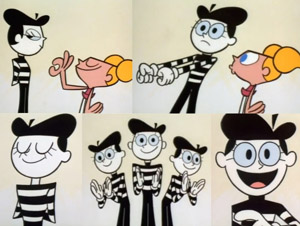 Back in the city, Dexter is being pursued by a wagon full of Keystone-like cops in a classic comic silent-movie chase. Dexter’s trickery with banana peels and back-and-forth chasing through a row of intersections resembling an Avery row of corridor doors has the cops getting nowhere, until all chasing comes to a halt, as Dexter smacks into an invisible wall, and encounters the silent Dee Dee, dressed in her new mime suit. A battle of pranks ensues as the cope look on. Dee Dee throws an invisible lasso, but Dexter ducks. Dexter throws a pie, but Dee Dee jumps clear of it. Dee Dee pulls back on an invisible bow and arrow, connecting with a fleeing Dexter and hauling him back to her by an invisible rope. Dee Dee picks up a heavy imaginary safe and lifts it over Dexter’s head, dropping it upon him. She then packages the stunned Dexter in an invisible box, ties it firmly shut with more invisible rope, and hauls Dexter away. The cops wonder if they should take Dexter into custody, but conclude that the mime has the situation well in hand. Dexter is returned to his laboratory, where his computer has finally calculated an antidote, and emerges from the steam of a treatment chamber, completely cired. Dexter thanks Dee Dee for her help, but adds confidently that he would have figured his own way out of the problem eventually. He turns to walk away, but runs smack into another invisible wall. He turns back toward Dee Dee, and runs into another. “Dee Dee, quit clowning around!”, yells Dexter. Dee Dee pulls on an imaginary curtain-pull, lowering a “The End” sign in front of the camera for the fade out.
Back in the city, Dexter is being pursued by a wagon full of Keystone-like cops in a classic comic silent-movie chase. Dexter’s trickery with banana peels and back-and-forth chasing through a row of intersections resembling an Avery row of corridor doors has the cops getting nowhere, until all chasing comes to a halt, as Dexter smacks into an invisible wall, and encounters the silent Dee Dee, dressed in her new mime suit. A battle of pranks ensues as the cope look on. Dee Dee throws an invisible lasso, but Dexter ducks. Dexter throws a pie, but Dee Dee jumps clear of it. Dee Dee pulls back on an invisible bow and arrow, connecting with a fleeing Dexter and hauling him back to her by an invisible rope. Dee Dee picks up a heavy imaginary safe and lifts it over Dexter’s head, dropping it upon him. She then packages the stunned Dexter in an invisible box, ties it firmly shut with more invisible rope, and hauls Dexter away. The cops wonder if they should take Dexter into custody, but conclude that the mime has the situation well in hand. Dexter is returned to his laboratory, where his computer has finally calculated an antidote, and emerges from the steam of a treatment chamber, completely cired. Dexter thanks Dee Dee for her help, but adds confidently that he would have figured his own way out of the problem eventually. He turns to walk away, but runs smack into another invisible wall. He turns back toward Dee Dee, and runs into another. “Dee Dee, quit clowning around!”, yells Dexter. Dee Dee pulls on an imaginary curtain-pull, lowering a “The End” sign in front of the camera for the fade out.
Next Time: A visit or two with one last TV icon, then on to features.


 Charles Gardner is an animation enthusiast who toils by day as a member of LA Law – but by nights and weekends indulges in classic jazz and ragtime as a performer; and studies classic Hollywood cartoons… maybe a little too much.
Charles Gardner is an animation enthusiast who toils by day as a member of LA Law – but by nights and weekends indulges in classic jazz and ragtime as a performer; and studies classic Hollywood cartoons… maybe a little too much.


































































































































































I can’t wait to see you discuss “We’re Back! A Dinosaur’s Story” with Professor Screweyes’ Eccentric Circus.
I don’t recall ever having seen either of these episodes of “Batman: the Animated Series”, but they’re certainly up to the series’ high standards: imaginative stories, exciting action, dramatic music, and first-rate acting. I was delighted to note that Roddy McDowall voiced the Mad Hatter in “Animal Act”, as he had guest starred as the Bookworm, wearing another ridiculous hat, in the Batman series of the 1960s. “Rudely stamped” Richard, the Shakespeare-quoting ringmaster in “Sideshow”, delivers a couple of excerpts from Marc Antony’s funeral oration in “Julius Caesar”. B:TAS didn’t quote Shakespeare nearly as often as “Star Trek” or “My Favorite Martian”, but it was still a very smart show.
“Seal Boy” is a perfectly appropriate nickname for young Billy in “Sideshow”, as the medical term for his condition is phocomelia, which means “seal limbs”. In the 18th century, a phocomelic dwarf named Matthew Buckinger was a popular performer throughout northern Europe, an accomplished artist, musician, magician, and marksman. He was married four times and fathered fourteen children, all of whom had normal limbs. History has not recorded whether or not he could swim.
For me, the real highlight of the Kwicky Koala show were the segments with Crazy Claws, a Grouchoesque cat whose lines often made me laugh.
It took me a while that the “Dexter’s Laboratory” episode, “The Laughing”, was spoofing “The Wolfman” because of the tropes, shortly it’s title was parodying of the horror film, “The Howling”.